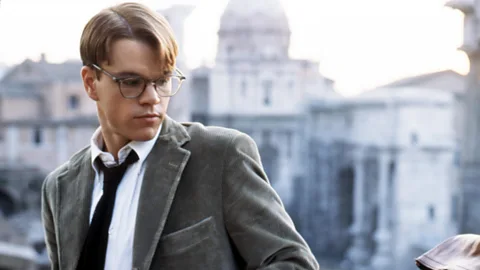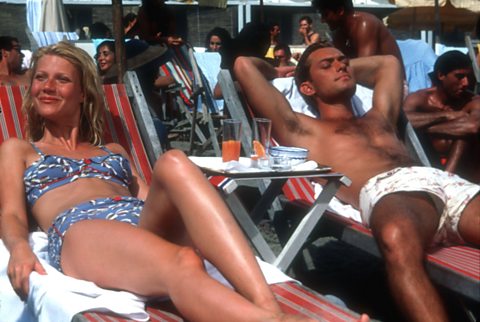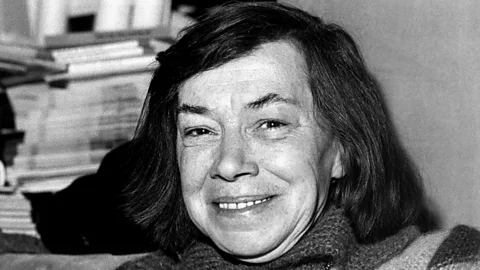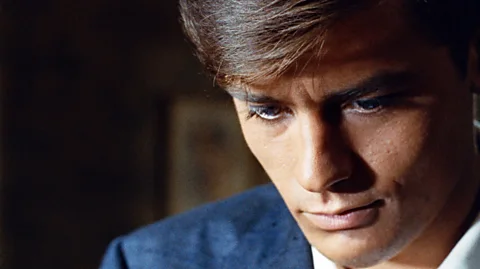The Talented Mr Ripley is a sociopath for our Instagram age
 Alamy
AlamyTwenty years on, Anthony Minghella’s take on Patricia Highsmith’s novel is a classic – and its story of a social-climbing con-man is more pertinent than ever, writes Hugh Montgomery.
“You can be a leech – you know that – and it’s boring. You can be quite… boring.” I don’t think any words in cinema are as seared into my memory as those said by Jude Law’s Dickie Greenleaf to Matt Damon’s Tom Ripley in the 1999 psychological thriller The Talented Mr Ripley.
They come at the film’s crux point, when, in a motorboat off the coast of San Remo, the unlikely friendship between the awkward, nondescript Ripley and the dazzling playboy Dickie is in the process of being severed by the latter. Dickie’s fusillade of taunts are the final straw for Ripley; his devoted hanger-on becomes his killer, violently pummelling him with an oar. Meanwhile, for this socially insecure 16-year-old, watching the film in the cinema, the utter derision of Law and those ‘borings' seemed to express an ultimate horror: that as a human being, we might be neither loved, nor hated, but simply deemed unworthy of attention.
More like this
Twenty years on today from its original US release, Anthony Minghella’s adaptation of Patricia Highsmith’s novel remains far from boring, however. As a lavish period drama co-produced by The Weinstein brothers’ company Miramax during its imperial phase, with an of-the-moment star cast and the director of The English Patient at the helm, it had many of the hallmarks of awards-season bait. And yet, where equivalent productions like The English Patient, Shakespeare in Love and The Cider House Rules have faded fast from the collective memory, Ripley is even more striking in retrospect, as oddly prescient as it is darkly subversive.
 Alamy
AlamyMuch of the credit for the film’s enduring power must, of course, go back to Highsmith herself: the eccentric, acerbic US writer who, in Tom Ripley, created perhaps literature’s greatest con-man – and an enigma who continues to flourish in popular culture. Aside from his multiple film incarnations, there is now a new Ripley TV series in the works starring Fleabag’s Hot Priest Andrew Scott. In publishing, there have been various ‘Ripley-esque’ thrillers hitting the shelves in recent years – and recently, that adjective has found itself applied to real-life news stories almost as frequently.
Highsmith is of course known for other works, including fellow thriller Strangers on a Train and romance The Price of Salt, which themselves have both had excellent film adaptations (the latter as Carol). However it is Ripley with whom her name is most synonymous; she devoted five books to his nefarious, murderous adventures.
The sequels in the so-called ‘Ripliad’ are enjoyably perverse jeux d’esprits, in which Highsmith gives us the transgressive thrill of seeing Ripley get away again and again with his crimes, whether that’s impersonating a deceased artist or garotting Mafia heavies.
The genesis of a killer
But the original novel is a work both more sincere and more profound. If what Ripley turns into through the series is a near-comically unruffled sociopath, then The Talented Mr Ripley proves how sociopaths are made, not born.
In the opening section, set in New York, Highsmith paints a portrait of a man living painfully on the margins: someone with no real intimate ties who had moved to the city and taken up with “silly stupid people in order not to be lonely”.
When, therefore, he is misidentified by the shipping magnate Herbert Greenleaf as a friend of his wayward son, and asked to go to Italy to cajole him into returning home, Ripley undertakes the trip as an escape from himself. On the boat on the way there, he reflects on how he had “the world’s dullest face, a thoroughly forgettable face with a look of docility that he could not understand… A real conformist’s face, he thought.” Dickie Greenleaf would seem to be his polar opposite – charismatic and non-conformist. Though the irony is that he can play the rebel only because he has the establishment wealth that allows him to.
 Alamy
AlamyOn one level, The Talented Mr Ripley functions as a near-satirical study in society’s masochistic iration of the privileged. Tom isn’t impressed with Dickie because of any discernible talent he has: towards the end of the book, he tells a private detective that “Dickie was a very ordinary young man who liked to believe himself extraordinary”. And yet he cannot help but look up to him “with a heart-breaking surge of envy and self-pity” – an envy that es into adoration.
Highsmith’s genius is to convey the gut-wrenching rise and fall of a friendship with such economy. Within just over 50 pages, we see Ripley go from unwanted interloper in Dickie’s charmed life to trusted confidant – before, just as swiftly, he is frozen out again like “an unwelcome, boring guest” who has overstayed their welcome. This culminates in one of the most exquisite ages about heartbreak – because that is what it is – in literature: “It was as if Dickie had suddenly been snatched away from him. They were not friends. They didn’t know each other. It struck Tom like a horrible truth, true for all time, true for the people that he had known in the past and for those he would know in the future: each had stood and would stand before him, and he would know time and time again that he would never know them, and the worst was that there would always be the illusion, for a time, that he did know them, and that he and they were completely in harmony and alike.”
And so it is that, even after Dickie is at the bottom of the sea and Ripley has assumed his identity, the book balances a caper-ish quality and acid-tongued humour with an undertow of deep melancholy. Again and again, Ripley’s elan at evading the law while posing as Dickie is balanced by his self-hatred when he is required to revert to his ‘true’ self. “He hated becoming Thomas Ripley again, hated being nobody,” as Highsmith puts it towards the end. It is, most potently, a study of loneliness – that great taboo of a disease over which so much shame hangs, and that we still struggle as a society to address. A disease that renders people invisible – invisibility being both Ripley’s great skill and his great curse.
Ripley adapted
The slipperiness of Highsmith’s tone when it comes to Ripley is perhaps reflected by the range of Ripley adaptations. The Talented Mr Ripley was first adapted by the French director Réne Clément; Plein Soleil, or Purple Noon (1960), stars Alain Delon as Ripley. It’s a beautiful and superficially entertaining film but a little empty: Delon is simply too absurdly handsome to convince as a malleable ‘nobody’ and it ends with Ripley being caught, an unforgivable change which Highsmith herself declared to be “a terrible concession to so-called public morality”.
Other Ripley adaptations have included Wim Wenders’ The American Friend (1977) and Liliana Cavani’s Ripley’s Game (2002), both adaptations of the third book in the Ripliad: the former stars the unlikely figure of Dennis Hopper as a kind of cowboy figure, complete with Stetson, while the latter features John Malkovich as a high-camp aesthete, pre-occupied by making souffles and practising his yoga moves as much as he is by criminality and murder.
 Alamy
AlamyBut of all the cinematic takes, it is Minghella’s that really endures. What Highsmith would have thought of it, as with the other adaptations, is questionable; it certainly changes her work into something more sentimental and more ‘Hollywood’. Where in the book, for example, Ripley’s boat-bound murder of Dickie is somewhat pre-meditated, in Minghella’s version it is a crime ionnel, brought on by the latter’s hurtful insults. And Marge Sherwood, the woman who is Ripley’s nemesis as the rival for Dickie’s affections, is turned from a slightly dim-witted gull into the one person who can see through Ripley’s scheming – and ends the film fighting to get others to believe her.
Queering the story
But its most obvious liberty is in making Highsmith’s story into an explicitly queer one – and putting sex and sexuality front and centre. Ripley is both very overtly in love – and lust – with Dickie: this comes to a head in a candlelit, smoulderingly erotic scene in which a fully-clothed Ripley plays chess with an unclothed Dickie as he lounges in the bath, before asking if he can get in.
In Highsmith’s conception, things are rather more ambiguous: Ripley faces questions about his sexuality from Dickie and Marge, but is at pains to brush them off. Phyllis Nagy, a friend of Highsmith who both wrote the film Carol and has adapted The Talented Mr Ripley for the stage, has suggested Ripley's equivocation had parallels with Highsmith’s own attitude to her sexuality: “[she] would often say 'Oh, he's bisexual' — and I would raise an eyebrow. Because like Tom, Pat would never say, 'I’m gay,' even though she was — and really didn’t hide it.” In the subsequent Ripley books, he is married to a woman, Heloise, and the subject recedes.
But if Minghella’s film dares to take liberties with the source material, then that is, as with many of the best adaptations, to its credit. Rewatching it now, it remains an exquisitely assembled and appointed piece of work. Firstly, of course, there’s the sheer luxuriant style of the thing: from the fractured, Saul Bass-indebted opening credits to the Riviera chic costuming and the spine-tingling soundtrack, which includes Matt Damon’s painfully intimate rendition of My Funny Valentine, there is not a hair or frame out of place.
Then there is the casting. As Dickie and Marge, Jude Law and Gywneth Paltrow bring a kind of meta-allure to proceedings that still carries. Back then, after all, they represented the most gilded princelings of modern celebrity. Paltrow, complete with her Oscar, blue-chip family connections (Steven Spielberg is her godfather) and A-list heartthrob boyfriends, was Hollywood’s brightest young thing. Law, on the other side of the Atlantic, was one of the key players in the so-called Primrose Hill set. The knowledge of this can’t help but feed into their perfectly to-the-manner-born screen aura – which shines bright right from their opening scene where Damon’s Ripley “accidentally” runs into them on the beach, and they squint up from their loungers in amused bemusement at this pasty, fluorescently speedo-ed interloper as if he was a strange subterranean creature. Law, especially, exudes a kind of privileged unselfconsciousness: on the flipside, as the Ripley-Dickie friendship disintegrates, he gives brilliant scowl, that captures the very essence of elitist contempt.
 Alamy
AlamyDamon, meanwhile, is revelatory. At the time, he was riding high off the back of Good Will Hunting as a Hollywood golden boy himself. Yet as Ripley, he manages to transform himself into someone both totally ordinary looking and painfully uncomfortable in his own skin, from his gummy, toothy grin onwards.
And the riches don’t stop there; Minghella allows space for two further sterling performances. Taking on a role specially written for the film, Cate Blanchett plays Meredith Logue, a starry-eyed heiress who falls in love with Ripley’s fake Dickie, and adds a beguiling dose of sincerity to proceedings. Meanwhile in the expanded role of Freddie Miles, Dickie’s old school friend, Philip Seymour Hoffman barrels into the film in an open-top sports car and embodies all the most monstrous consequences of inherited wealth.
Above all, though, Minghella’s twin decisions to downplay Highsmith’s caustic humour, and to bring Ripley’s closeted sexuality into the open, both pay off. It becomes a tale not just of loneliness, but much more obviously of queer loneliness – and one with a tragic arc. For all that he becomes, Damon’s Ripley has a puppyish tenderness when entranced by Dickie that makes his rejection – not just by the object of his affection but the whole ‘straight’ establishment world he represents – sting hard.
Most painful of all is the moment, at the crux of Ripley and Dickie’s friendship breakdown, when Dickie returns unexpectedly home to find Ripley dressed up in his clothes. In the film version, the embarrassment of the situation is obviously heightened by Ripley’s camp posing: he is sans tros, twirling around to the tune of Bing Crosby’s May I. It is an archetypal moment of ‘gay shame’.
The amplification of the story’s queerness is finally compounded by the heart-breaking ending that Minghella conceives. The director gives his protagonist a male lover – Jack Davenport’s Peter Smith-Kingsley, a very minor non-lover character in the book – only for him to destroy his chance at romantic happiness in the most brutal fashion possible. With Peter about to cotton onto Ripley’s deceptions, Ripley slowly crushes him to death, off-camera – his lover unaware until the last minute that he is killing him, not embracing him. It’s a conclusion that affirms the abject alienation of leading a double life, in more ways than one.
The modern-day Ripley stories
But beyond its status as a modern queer classic, the film, and the Ripley story, continue to resonate much more broadly in the cultural landscape. As mentioned before, stories in the news with parallels to Highsmith’s tale abound. This year, we’ve had the saga of notorious Instagram influencer Caroline Calloway and her bitter former friend and ‘ghostwriter’ Natalie Beach, which one pundit described as “all very Tom Ripley/Dickie Greenleaf”; and the conviction of a very modern-day Ripley figure, Anna Sorokin, who conned her way through New York high society as a ‘fake heiress’ and stole more than $200,000 from friends, banks, hotels and restaurants in the process.
 Getty Images
Getty ImagesAnd then there was the New Yorker’s astonishing takedown of fabulist crime writer Dan Mallory, who among other things, lied for years about having brain cancer, adopted a fake British accent, falsely claimed his mother was dead, and wrote emails to colleagues impersonating his brother. It’s a story filled with numerous, explicit Ripley allusions. Among them is the fact that as a graduate student at Oxford, Mallory had set out to do his PhD on Highsmith – which in an ironic twist, went unfinished, but he lied about having completed. Meanwhile, his bestselling book The Woman in the Window referenced Ripley, and a former colleague of his is quoted as saying “There’s this guy in the office who has a Talented Mr Ripley thing going on.”
The profusion of ‘Ripley-esque’ stories is perhaps no coincidence. For the con-artistry of Ripley speaks more than ever to our Instagram age, where the carefully-curated and crafted image trumps reality. (That stands in comparison to the previous, more unfiltered, embryonic age of social media, where s dropped reams of photos onto Facebook at once, in a notional attempt to reveal, rather than conceal, their reality.)
In fact, a film already exists that might rightfully be called the ‘The Talented Mr Ripley for the Instagram age’: the very fine 2017 black comedy Ingrid Goes West, about a loner twenty-something woman who becomes obsessed with a Californian social media influencer she reads about in a magazine, inveigling her way into her life.
What’s more, The Talented Mr Ripley not only chimes with our Instagram age thematically, but visually: from casually elegant vintage fashions to the mixing of martinis and sepia-toned shots of idyllic Mediterranean getaways, a certain Ripley aesthetic seems to represent the height of retro-centric social-media aspiration.
Who’s the Ripley?
And if Highsmith’s creation speaks to our age so strongly, it’s perhaps because even the Dickies of this world are really Ripleys now. In the case of the Calloway story, for example, you might think of casting Calloway as the Dickie figure – rich, privileged and careless of other people – and Beach (the envious friend swept up into her gilded lifestyle) as the Ripley. But that would be to ignore the fact that Calloway, with her hordes of fake Instagram followers, ghostwritten posts, and spectacularly bad value $165 ‘creativity workshops’, was equally the crook.
Meanwhile, in court, Sorokin’s lawyer tried to mitigate her deceptions by explaining how she was merely fitting into a milieu built on lies. “In her world, this is what her social circle did,” he said. “Everyone’s life was perfectly curated for social media. People were fake. People were phoney. And money was made on hype alone.”
 Alamy
AlamyBut then really that was Highsmith’s point all along. She is wise to the tricks that the privileged employ to prop up their sense of superiority, even if those often, paradoxically, involve a kind of affected modesty: take Dickie’s precious, ‘old-fashioned’ refusal to own a fridge or even an ice-box, or Ripley’s observation that “in Europe… inadequate heating was a hallmark of chic in winter”. One of the best lines in the film comes when Blanchett’s Meredith, with a total lack of self-awareness, declares that “The truth is if you’ve had money your entire life – even if you despise it, which we do... you’re only truly comfortable around other people who have it and despise it.”
Meanwhile another stand-out zinger of Minghella’s script is when he has Dickie laughingly declare of his university Princeton that it was the “cream of America: rich and thick” (which, with delicious irony, intended or not, is a steal from Samuel Beckett, who said the same thing about Trinity College, Dublin). The greatest scammers of all, of course, are those that need no disguises.
Love film? BBC Culture Film Club on Facebook, a community for film fanatics all over the world.
If you would like to comment on this story or anything else you have seen on BBC Culture, head over to our Facebook page or message us on Twitter.
And if you liked this story, sign up for the weekly bbc.com features newsletter, called The Essential List. A handpicked selection of stories from BBC Future, Culture, Worklife and Travel, delivered to your inbox every Friday.
